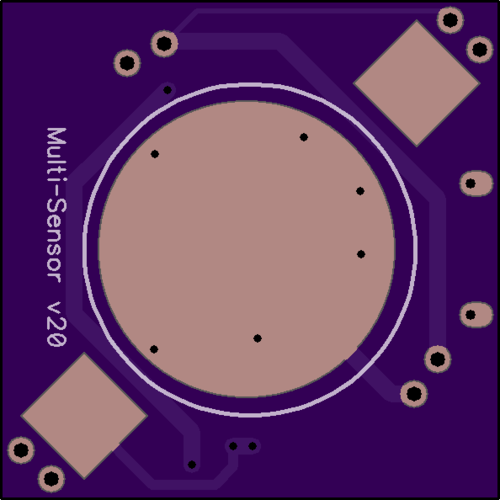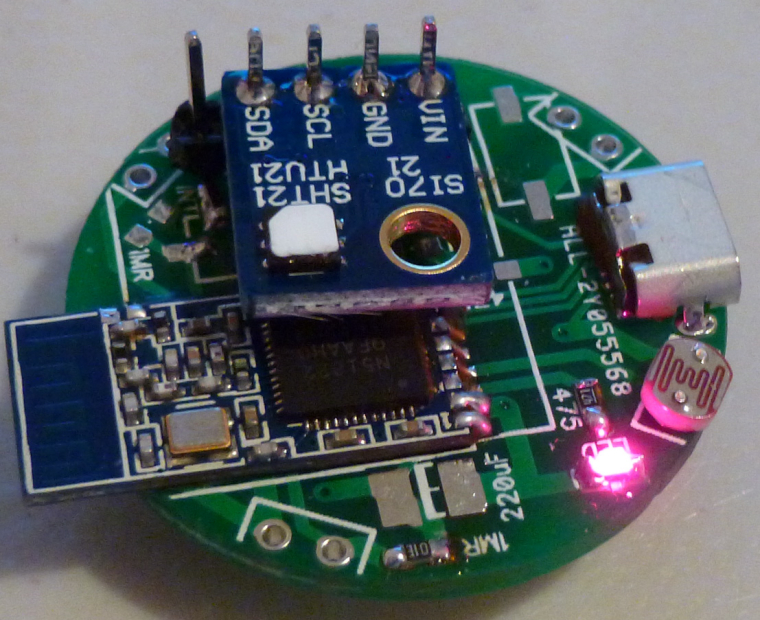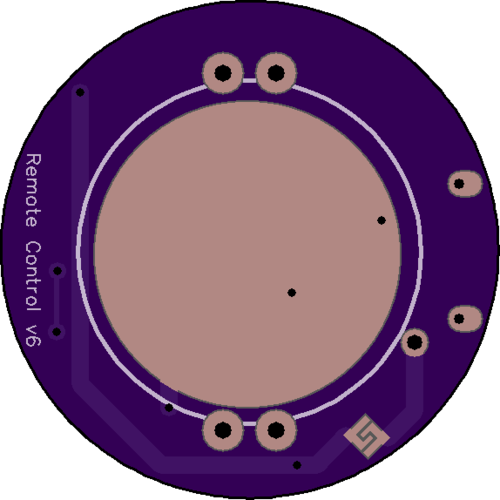nRF5 action!
-
I received a battery clip designed to hold two CR2032's in series, but I was surprised to find how much wider it is than a single cell holder:

Why? And, is that how they all are?So, at this point, I either need to increase the PCB diameter again, or else go square and hang this clip diagonally.
You may ask, why do this at all? One of the reasons is that the AM612 PIR requires a minimum of 2.7v, and a single CR2032 doesn't leave much headroom, especially given the dippy discharge nature of coincells. I figure two CR2032's in series with a voltage regulator should, in theory, manage the issue a lot better. Indeed, with that in mind, I already have PCB's with the pads for a voltage regulator on them, but I didn't expect the battery clip to be so big.
-
I did a quick hack for testing purposes:


With all this extra space, I could probably add the hall sensor back in. I had taken it out so that I'd have the option of adding an extra LED, plus two pushbuttons. -
I found a much better 2x battery clip made by Linx. Even though it's through-hole rather than surface mount, its footprint is much smaller. https://www.mouser.com/Search/ProductDetail.aspx?R=BAT-HLD-001-THMvirtualkey66280000virtualkey712-BAT-HLD-001-THM
Using it, I don't have to enlarge the diameter or go square. I can keep the same size. -
@toyman said in nRF5 Bluetooth action!:
@neverdie frankly, I would revive CR2450 idea. 620mah vs 200mah is HUGE difference
If I can keep the footprint the same (and I don't see why not), I could attach a 2x battery clip for a 2450, and then you'd have the best of both worlds. I have a hunch that finding such a clip, though, won't be easy.
-
@neverdie
maybe check out: https://www.aliexpress.com/item/5pcs-20-0mm-CR2032-2032-Battery-Button-Cell-Holder-Coin-Cell-Retainer-Battery-Holder-Through-hole/32741947070.html?spm=a2g0s.9042311.0.0.E38CWgor if you need 50... :
https://www.aliexpress.com/item/50pcs-20-0mm-CR2032-2032-Battery-Button-Cell-Holder-Coin-Cell-Retainer-Battery-Holder-Through-hole/32739802992.htmlprice wise,, i would say, go for the second one ;)
-
@neverdie
maybe check out: https://www.aliexpress.com/item/5pcs-20-0mm-CR2032-2032-Battery-Button-Cell-Holder-Coin-Cell-Retainer-Battery-Holder-Through-hole/32741947070.html?spm=a2g0s.9042311.0.0.E38CWgor if you need 50... :
https://www.aliexpress.com/item/50pcs-20-0mm-CR2032-2032-Battery-Button-Cell-Holder-Coin-Cell-Retainer-Battery-Holder-Through-hole/32739802992.htmlprice wise,, i would say, go for the second one ;)
@omemanti Thanks.
I ordered the Linx from mouser yesterday, though. It uses four smaller pins instead of two larger pins. That actually helps keep the footprint small. Also, Linx has practically identical holders for holding a single CR2032 versus holding two CR2032's. That means I can use a single PCB board and decide which configuration I want. The mouser price is quite reasonable (about 25 cents each).
I did try looking for a holder that can hold two CR2450's in series, but I didn't find any.
-
I received the Linx parts today. I like them more than any other battery holders I've yet seen, because they elevate the sides just a smidge, which eliminates any risk of short-circuiting to nearby through-holes. For instance, the ones from Aliexpress (linked above by Omemtani) don't do that. Nor do any of the other ones I've tried so far.
On Tuesday I should receive PCB's specifically designed to use the Linx holders. I can hardly wait.
-
I just noticed these small and fairly cheap nRF52 modules on Aliexpress:
https://www.aliexpress.com/item/wholesale-Holyiot-TinyBLE-nRF52832-Bluetooth-low-energy-module-BLE-5-0-for-Bluetooth-mesh/32840369737.html?spm=2114.search0204.3.2.eQaXfB&ws_ab_test=searchweb0_0,searchweb201602_4_10152_10065_5000015_10151_10344_10068_10130_10345_10324_10342_10547_10325_10343_51102_10546_10340_10341_10548_10545_5130015_10541_10084_10083_10307_5690015_10539_5080015_10312_10059_10313_10314_10534_100031_10604_10603_10103_10605_10594_5060015_10596_10142_10107,searchweb201603_14,ppcSwitch_4_ppcChannel&algo_expid=f4f4f444-b2af-44da-9380-676cdca3c65f-0&algo_pvid=f4f4f444-b2af-44da-9380-676cdca3c65f&rmStoreLevelAB=0
But how would one solder it? Is solder paste the only option? -
Here's one for the blooper reel:

I blithely put the photoresistor in one of the vacant leak detection slots. Of course, in retrospect, it's an obvious mistake: too close to the LED. So, when the LED lights, the photoresistor thinks it's suddenly bright out. :laughing: -
I just noticed these small and fairly cheap nRF52 modules on Aliexpress:
https://www.aliexpress.com/item/wholesale-Holyiot-TinyBLE-nRF52832-Bluetooth-low-energy-module-BLE-5-0-for-Bluetooth-mesh/32840369737.html?spm=2114.search0204.3.2.eQaXfB&ws_ab_test=searchweb0_0,searchweb201602_4_10152_10065_5000015_10151_10344_10068_10130_10345_10324_10342_10547_10325_10343_51102_10546_10340_10341_10548_10545_5130015_10541_10084_10083_10307_5690015_10539_5080015_10312_10059_10313_10314_10534_100031_10604_10603_10103_10605_10594_5060015_10596_10142_10107,searchweb201603_14,ppcSwitch_4_ppcChannel&algo_expid=f4f4f444-b2af-44da-9380-676cdca3c65f-0&algo_pvid=f4f4f444-b2af-44da-9380-676cdca3c65f&rmStoreLevelAB=0
But how would one solder it? Is solder paste the only option?@neverdie said in nRF5 Bluetooth action!:
I just noticed these small and fairly cheap nRF52 modules on Aliexpress:
But how would one solder it? Is solder paste the only option?I have bought two to check the range but I don't have very high expectations about that :D
For soldering it should work the same way than with qfn chips:- put a bit of solder on each pad of the module, then use solder wick to remove excess so it's just lightly tinned
- put a bit of solder on PCB pads
- put chip in place, then heat up with hot air gun
Here as it's a module the hot air might unsolder some components, so using regular iron, flux and a bit oversized pads (so you can heat them up with soldering iron) should do the trick. I will try and tell you the result.
-
@neverdie said in nRF5 Bluetooth action!:
I just noticed these small and fairly cheap nRF52 modules on Aliexpress:
But how would one solder it? Is solder paste the only option?I have bought two to check the range but I don't have very high expectations about that :D
For soldering it should work the same way than with qfn chips:- put a bit of solder on each pad of the module, then use solder wick to remove excess so it's just lightly tinned
- put a bit of solder on PCB pads
- put chip in place, then heat up with hot air gun
Here as it's a module the hot air might unsolder some components, so using regular iron, flux and a bit oversized pads (so you can heat them up with soldering iron) should do the trick. I will try and tell you the result.
@nca78 "At first I was afraid, I was petrified" :-), but then I relialized that if "recepting" pads are long enough even plain soldering iron will do.
The solder will just flow under the module provided module pads are pretinned Ias you recommended) -
I received the Linx parts today. I like them more than any other battery holders I've yet seen, because they elevate the sides just a smidge, which eliminates any risk of short-circuiting to nearby through-holes. For instance, the ones from Aliexpress (linked above by Omemtani) don't do that. Nor do any of the other ones I've tried so far.
On Tuesday I should receive PCB's specifically designed to use the Linx holders. I can hardly wait.
@neverdie said in nRF5 Bluetooth action!:
I received the Linx parts today. I like them more than any other battery holders I've yet seen, because they elevate the sides just a smidge, which eliminates any risk of short-circuiting to nearby through-holes. For instance, the ones from Aliexpress (linked above by Omemtani) don't do that. Nor do any of the other ones I've tried so far.
On Tuesday I should receive PCB's specifically designed to use the Linx holders. I can hardly wait.
I received the PCB's a day early. Unfortunately, it's almost total fiction to say that the Linx holder is designed to hold two CR2032's. Instead, it can hold one CR2032 comfortably, or, with finessing, it can hold two CR2025's. With extreme finessing I did get it to hold two CR2032's, but it will be touch-and-go as to whether the solder joints will hold long-term under the strain. Aside from the small footprint, I'm not happy with it. :(
-
@neverdie said in nRF5 Bluetooth action!:
I received the Linx parts today. I like them more than any other battery holders I've yet seen, because they elevate the sides just a smidge, which eliminates any risk of short-circuiting to nearby through-holes. For instance, the ones from Aliexpress (linked above by Omemtani) don't do that. Nor do any of the other ones I've tried so far.
On Tuesday I should receive PCB's specifically designed to use the Linx holders. I can hardly wait.
I received the PCB's a day early. Unfortunately, it's almost total fiction to say that the Linx holder is designed to hold two CR2032's. Instead, it can hold one CR2032 comfortably, or, with finessing, it can hold two CR2025's. With extreme finessing I did get it to hold two CR2032's, but it will be touch-and-go as to whether the solder joints will hold long-term under the strain. Aside from the small footprint, I'm not happy with it. :(
I guess for now, until something better can be found, I'll simply make do with either 1x CR2032 (240mah) or 2x CR2016 (effectively 100mah).
-
Here's my latest remote control:


It has a pa-lna nRF52832 which can draw up to 250ma during Tx. It's powered by two CR2032's but draws absolutely zero current unless one of the buttons is pressed.
If powered through the connector, however, it can run continuously, without either button being pressed. In that case, it could also serve as a transceiver, sending serial output over the connector.
It's small and has a nice feel to it. I'm happy with it. :)
-
In the next version I'm going to use a somewhat unusual shaped solder jumper, in case I want to use just a single coin cell battery (not two) and therefore bypass the LDO (well, not install an LDO at all).

-
-
@NeverDie I'm thinking about making the jump from NRF24s and RFM69s to the NRF5 eco system. I see you have tried quite a few different modules. If you had to pick now, would you go with the Fanstel BT832X for a gateway and BT832 for most modules?
@nagelc said in nRF5 Bluetooth action!:
@NeverDie I'm thinking about making the jump from NRF24s and RFM69s to the NRF5 eco system. I see you have tried quite a few different modules. If you had to pick now, would you go with the Fanstel BT832X for a gateway and BT832 for most modules?
Yes. If cost and space were no issue, I'd probably use the BT832X on everything, because it also has the best antenna. For nRF52's, for what I'm doing I like Fanstel's stuff the best. If I needed a module with more exposed pins, then the EByte would be my choice. But nothing I'm doing requires that many exposed pins, and I think the Fanstel will likely be drop-in upgradeable to the final nRF52840 modules when final silicon for that becomes available. Of course, there's no guarantee of that, but it seems very likely.
Also important, at least to me, is that the Fanstel modules have FCC approval, and being based in the US, I don't think they're lying about it (unlike random stuff from China).
That said, the nRF51822-04's are a lot of fun, because they're small and relatively cheap.
-
@nagelc said in nRF5 Bluetooth action!:
Great. I have some on order. Can't wait go start playing around with them.
Great! I invite you to start making posts to this thread when you do, as fresh perspectives are always welcome.
-
Hello, I want to build battery powered modules (with sleep). I found on Ebay NRF51822 round module with case (https://www.ebay.com/itm/hello/112650665753) - only $6.50 with shipping. Is this module is good choice? Any pitfalls?
I planning to use water leak sensor, BME280 (I2C), ds18b20(1-wire), maybe MH-Z19 later.
I don't have enough experience, I have only used ESP8266 NodeMcu V3 and Arduino before.
I can see one I2C (for programator and sensors?) and one GPIO as button for water leak (right?) + LED pin. Does this module have more pins? Shall I connect to chip legs to obtain more pins (GPIO) (does I need to connect resistors?) for 1-wire or better use some sort of I2C GPIO expander?
